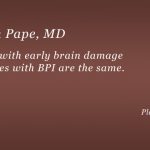Other video clips of Karen speaking: Karen at TEDx Winnipeg 2012 Habit Hides Recovery Primary movement patterns explained Uncovering normal neurology
Outliers by Malcolm Gladwell – New York: Little, Brown and Company, 2008
Malcolm Gladwell is one of my favorite writers. Each of his books has taught me to see the world in a slightly different way. Four years after my first reading […]
Primary movement patterns explained
Other video clips of Karen speaking: Karen at TEDx Winnipeg 2012 Habit Hides Recovery Babies with early brain damage or babies with BPI are the same. Uncovering normal neurology
Uncovering normal neurology
Other video clips of Karen speaking: Karen at TEDx Winnipeg 2012 Habit Hides Recovery Babies with early brain damage or babies with BPI are the same. Primary movement patterns […]
Great Ideas
Medical knowledge is doubling every 5-10 years. In the fields of neuroscience, neuropsychology, neuroimaging, sports and exercise physiology it may even be faster. However, one of the major problems confronting families and their health care teams is availability. Please consult your physician and therapists before trying any of these suggestions.
Never Too Late
Seeing Christine on the tennis court, it is hard to believe that she was born with choreoathetosis, a type of cerebral palsy that affects all 4 limbs and speech. Christine is living proof that adults with cerebral palsy and other early neurological problems can continue to improve throughout life. Our old beliefs that adults would necessarily deteriorate as they age are not necessarily true.
Brachial Plexus Injury
Children with a C5-6 brachial plexus birth injury initially have difficulty raising their hand over their head. This young girl has the typical “lift your arm” posture. It is an early learned habit. Doing jumping jacks, she can easily elevate her shoulder. New skills demonstrate recovery masked by habit.
Cerebral Palsy
This young boy with left sided hemiplegia walks with a limp but runs well both with and without his AFO. His usual walk with a limp was learned early with the damaged, immature brain. It is more fluid run was learned later with the recovered, more mature brain.



